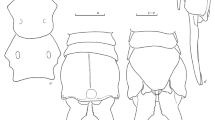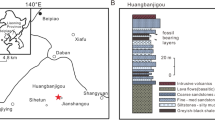Abstract
A new genus, Tologuica, with two species (T. aurorae sp. nov. and T. karhui sp. nov.), from the Middle Miocene of the Sharga locality (western Mongolia) is described. The new genus shares some characters with the extinct genera Palaeocryptonyx, Palaeortyx, and Plioperdix and with extant Coturnix. The foot structure suggests that Tologuica resembled in ecology the European genus Palaeortyx and was probably adapted to an arboreal mode of life, in contrast to the terrestrial Coturnix and Plioperdix.
Similar content being viewed by others
References
J. J. Baumel, A. S. King, J. E. Breazile, et al., Handbook of Avian Anatomy: Nomina Anatomica Avium (Publ. Nuttall Ornithol. Club, Cambridge, 1993), Vol. 23.
Z. Boev, “Chauvireria balcanica gen. n., sp. n. (Phasianidae-Galliformes) from the Middle Villafranchian of Western Bulgaria,” Geol. Balcan. 27(3–4), 69–78 (1997).
Z. Boev, “Fossil Record and Disappearance of Peafowl (Pavo Linnaeus) from the Balkan Peninsula and Europe (Aves: Phasianidae),” Hist. Natur. Bulg. 14, 109–115 (2002).
J. Cheneval, L. Ginsburg, and C. Mourer-Chauviré, “Discovery of an Avifauna from the Miocene of Northern Thailand,” CR Acad. Sci., Ser. 2. 299(19), 1369–1372 (1984).
J. Cheneval, L. Ginsburg, C. Mourer-Chauviré, and B. Ratanasthien, “The Miocene Avifauna of the Li Mae Long Locality, Thailand: Systematics and Paleoecology,” J. Southeast Asian Earth Sci. 6(2), 117–126 (1991).
Ch. Depéret, “Les animaux pliocènes du Roussilion,” Mèm. Soc. Géol. France. Paléontol., No. 3, 127–139 (1897).
E. V. Devyatkin, “Magnetostratigraphic Scheme of the Cenozoic of Mongolia,” Stratigr. Geol. Korrelyatsiya 2(2), 35–45 (1994).
U. B. Göhlich and C. Mourer-Chauviré, “Revision of the Phasianids (Aves: Galliformes) from the Lower Miocene of Saint-Gérand-Lu-Puy (Allier, France),” Palaeontology 48(6), 1331–1350 (2005).
U. B. Göhlich and M. Pavia, “A New Species of Palaeortyx (Aves: Galliformes: Phasianidae) from the Neogene of Gargano, Italy,” Oryctos 7, 95–108 (2008).
L. H. Hou, “Upper Miocene Birds from Lufeng, Yunnan,” Acta Anthropol. Sin. 4(2), 118–126 (1985).
L. H. Hou, “The Aragonian Vertebrate Fauna of Xiacaowan, Jiangsu: 6. Aves,” Vertebr. PalAsiat. 25(1), 57–68 (1987).
D. Janossy, “Late Miocene Bird Remains from Polgàrdi (W. Hungary),” Aquila 98, 13–35 (1991).
E. N. Kurochkin, “Methods for the Study of Extinct Birds,” in Special Methods for the Study of the History of Recent Ecosystems (Nauka, Moscow, 1979), pp. 152–163 [in Russian].
E. N. Kurochkin, “Middle Pliocene Rails from Western Mongolia,” Contrib. Sci. Natur. Hist. Mus. Los Angeles County., No. 330, 69–73 (1980).
E. N. Kurochkin, “Birds of Central Asia in the Pliocene,” Tr. Sovm. Sovet.-Mongol. Paleontol. Eksped. 26, 1–119 (1985).
C. Mourer-Chauviré, “A Peafowl from the Pliocene of Perpignan, France,” Palaeontology 32(2), 439–446 (1989).
M. A. Pevzner, E. A. Vangengeim, V. I. Zhegallo, et al., “Correlation of Late Neogene Deposits of Central Asia and Europe Based on Paleomagnetic and Biostratigraphic Data,” Izv. Akad. Nauk USSR, Ser. Geol., No. 6, 5–15 (1982).
P. V. Rich, L. H. Hou, K. Ono, and R. F. Baird, “A Review of the Fossil Birds of China, Japan and Southeast Asia,” Geobios, No. 19 (6), 755–772 (1986).
P. Švec, “The Fossil Pheasant (Aves; Phasianidae) from the Upper Miocene of D vinská Nová Ves (Slovakia),” Časop. Mineral. Geol. 31(1), 83–88 (1986).
H. K. Yeh, “First Discovery of Miocene Bird in China,” Vertebr. Palasiat. 15(3), 244–248 (1977).
H. K. Yeh, “Fossil Birds from Linqu, Shandong,” Vertebr. PalAsiat. 18(2), 116–125 (1980).
H. K. Yeh, “Third Note on Fossil Bird from Miocene of Linqu, Shandong,” Vertebr. PalAsiat. 19(2), 149–155 (1981).
H. K. Yeh and B. Sun, “New Material of Fossil Phasianid Bird from Linqu, Shandong,” Vertebr. PalAsiat. 22(3), 208–212 (1984).
V. S. Zazhigin and A. V. Lopatin, “History of Dipodoidea (Rodentia, Mammalia) in the Miocene of Asia: 1. Heterosminthus (Lophocricetinae),” Paleontol. Zh., No. 3, 90–102 (2000) [Paleontol. J. 34 (3), 315–327 (2000)].
V. S. Zazhigin and A. V. Lopatin, “History of Dipodoidea (Rodentia, Mammalia) in the Miocene of Asia: 4. Dipodinae at the Miocene-Pliocene Boundary,” Paleontol. Zh., No. 1, 61–75 (2001) [Paleontol. J. 35 (1), 58–72 (2001)].
Author information
Authors and Affiliations
Corresponding author
Additional information
Original Russian Text © N.V. Zelenkov, E.N. Kurochkin, 2009, published in Paleontologicheskii Zhurnal, 2009, No. 2, pp. 86–92.
Rights and permissions
About this article
Cite this article
Zelenkov, N.V., Kurochkin, E.N. Neogene phasianids (Aves: Phasianidae) of Central Asia: 1. Genus Tologuica gen. nov.. Paleontol. J. 43, 208–215 (2009). https://doi.org/10.1134/S0031030109020130
Received:
Published:
Issue Date:
DOI: https://doi.org/10.1134/S0031030109020130




